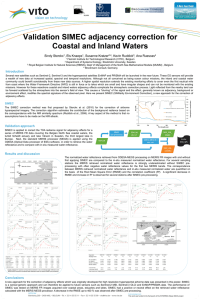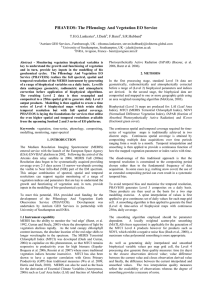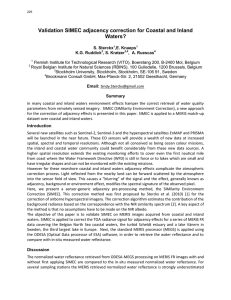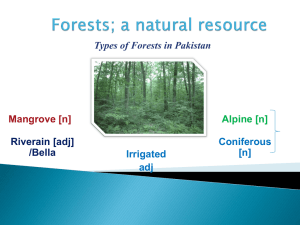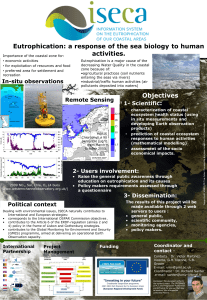LAND COVER CLASSIFICATION IN UKRAINIAN CARPATHIANS USING THE MERIS
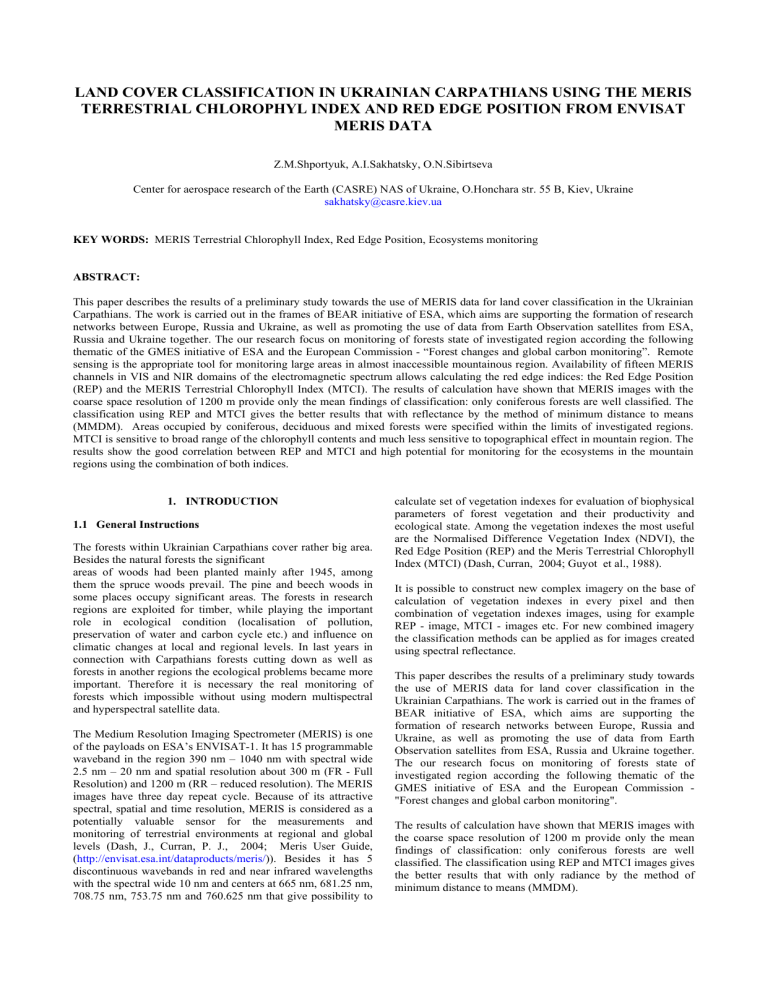
LAND COVER CLASSIFICATION IN UKRAINIAN CARPATHIANS USING THE MERIS
TERRESTRIAL CHLOROPHYL INDEX AND RED EDGE POSITION FROM ENVISAT
MERIS DATA
Z.M.Shportyuk, A.I.Sakhatsky, O.N.Sibirtseva
Center for aerospace research of the Earth (CASRE) NAS of Ukraine, O.Honchara str. 55 B, Kiev, Ukraine sakhatsky@casre.kiev.ua
KEY WORDS:
MERIS Terrestrial Chlorophyll Index, Red Edge Position, Ecosystems monitoring
ABSTRACT:
This paper describes the results of a preliminary study towards the use of MERIS data for land cover classification in the Ukrainian
Carpathians. The work is carried out in the frames of BEAR initiative of ESA, which aims are supporting the formation of research networks between Europe, Russia and Ukraine, as well as promoting the use of data from Earth Observation satellites from ESA,
Russia and Ukraine together. The our research focus on monitoring of forests state of investigated region according the following thematic of the GMES initiative of ESA and the European Commission - “Forest changes and global carbon monitoring”. Remote sensing is the appropriate tool for monitoring large areas in almost inaccessible mountainous region. Availability of fifteen MERIS channels in VIS and NIR domains of the electromagnetic spectrum allows calculating the red edge indices: the Red Edge Position
(REP) and the MERIS Terrestrial Chlorophyll Index (MTCI). The results of calculation have shown that MERIS images with the coarse space resolution of 1200 m provide only the mean findings of classification: only coniferous forests are well classified. The classification using REP and MTCI gives the better results that with reflectance by the method of minimum distance to means
(MMDM). Areas occupied by coniferous, deciduous and mixed forests were specified within the limits of investigated regions.
MTCI is sensitive to broad range of the chlorophyll contents and much less sensitive to topographical effect in mountain region. The results show the good correlation between REP and MTCI and high potential for monitoring for the ecosystems in the mountain regions using the combination of both indices.
1. INTRODUCTION
The forests within Ukrainian Carpathians cover rather big area.
Besides the natural forests the significant areas of woods had been planted mainly after 1945, among them the spruce woods prevail. The pine and beech woods in some places occupy significant areas. The forests in research regions are exploited for timber, while playing the important role in ecological condition (localisation of pollution, preservation of water and carbon cycle etc.) and influence on climatic changes at local and regional levels. In last years in connection with Carpathians forests cutting down as well as forests in another regions the ecological problems became more important. Therefore it is necessary the real monitoring of forests which impossible without using modern multispectral and hyperspectral satellite data.
The Medium Resolution Imaging Spectrometer (MERIS) is one of the payloads on ESA’s ENVISAT-1. It has 15 programmable waveband in the region 390 nm – 1040 nm with spectral wide
2.5 nm – 20 nm and spatial resolution about 300 m (FR - Full
Resolution) and 1200 m (RR – reduced resolution). The MERIS images have three day repeat cycle. Because of its attractive spectral, spatial and time resolution, MERIS is considered as a potentially valuable sensor for the measurements and monitoring of terrestrial environments at regional and global levels (Dash, J., Curran, P. J., 2004; Meris User Guide,
( http://envisat.esa.int/dataproducts/meris/ )). Besides it has 5 discontinuous wavebands in red and near infrared wavelengths with the spectral wide 10 nm and centers at 665 nm, 681.25 nm,
708.75 nm, 753.75 nm and 760.625 nm that give possibility to calculate set of vegetation indexes for evaluation of biophysical parameters of forest vegetation and their productivity and ecological state. Among the vegetation indexes the most useful are the Normalised Difference Vegetation Index (NDVI), the
Red Edge Position (REP) and the Meris Terrestrial Chlorophyll
Index (MTCI) (Dash, Curran, 2004; Guyot et al., 1988).
It is possible to construct new complex imagery on the base of calculation of vegetation indexes in every pixel and then combination of vegetation indexes images, using for example
REP - image, MTCI - images etc. For new combined imagery the classification methods can be applied as for images created using spectral reflectance.
This paper describes the results of a preliminary study towards the use of MERIS data for land cover classification in the
Ukrainian Carpathians. The work is carried out in the frames of
BEAR initiative of ESA, which aims are supporting the formation of research networks between Europe, Russia and
Ukraine, as well as promoting the use of data from Earth
Observation satellites from ESA, Russia and Ukraine together.
The our research focus on monitoring of forests state of investigated region according the following thematic of the
GMES initiative of ESA and the European Commission -
"Forest changes and global carbon monitoring".
The results of calculation have shown that MERIS images with the coarse space resolution of 1200 m provide only the mean findings of classification: only coniferous forests are well classified. The classification using REP and MTCI images gives the better results that with only radiance by the method of minimum distance to means (MMDM).
Areas occupied by coniferous, deciduous and mixed forests were specified within the limits of investigated regions. MTCI is sensitive to broad range of the chlorophyll contents and much less sensitive to topographical effect in mountain region.
The significant volumes of forest inventory data within
Carpathian National Natural Park (CNNP) at southwest of
Ivano-Frankovsk oblast (West Ukraine) were used as ground truth information.
The classified Landsat-7 ETM image was used as reference information for evaluation of results of MERIS data processing on land cover classification.
2. DATA SOURCES AND METHODS signatures for the selected classes. Spectral characteristics for separate forest vegetation species and different landscapes were analysed using approximately four or five test sites within area for every class.
The reduced resolution image ENVISAT/MERIS level1b recorded on April 16, 2004 have been used. MERIS (RR) image was provided by ESA in the frames of BEAR initiative.
Specification of the spectral bands are given in Website (Meris
User Guide). MERIS data were converted to ERDAS Imagine format using programs BEAM and ENVI. The image covers the whole territory of investigation and also areas far from the boundaries of research regions. Therefore, after the geometric correction the MERIS data were cut for territory of West
Ukraine within coordinates 23 o 20' and 24 o 50' E and 48 o and
49 o 15’N. The research area is shown in figure 1. The fragment of ENVISAT MERIS image (combination of 4, 7 and 14 channels) for research area is demonstrated in figure 2.
The Landsat-7 ETM image (in 7 standard spectral bands) recorded on May 5, 2000 was used as reference information for comparison with MERIS data.
The Forest Inventory data structured according to forest districts and administrative areas have been used as ground truth data for classification of satellite images. Forest Inventory data include information about tree species composition, age, height origin, site index and relative stocking etc. for relatively homogenous area (Primary Inventory Units). This data in GIS format located within Carpathian National Natural Park were used in this study. Their spatial and attribute data were updated to 1996. The number of Primary Inventory Units within the test polygon generally exceeds several hundred units. The investigated territory is dominated by heterogeneous coniferous forests with a prevalence of spruce. The pine and deciduous forests (mainly beech and alder) in some sites occupy significant territory.
The classification of satellites data has been carried out using the modules of ERDAS Imagine program. The method of minimum-distance to means for classification of ENVISAT
MERIS data was applied, because areas of interest (AOI) sometimes cover only 1-2 pixels of images.
However, the Maximum Likelihood decision rule has been used for classification of Landsat-7 image (5 May, 2000) (figure 2f) to obtain more accurate reference data for comparison.
Reliability of the given high resolution images classification for main classes is usually more then 85 – 95 % according our investigations. As a first step, the analysis of spectral brightness was performed for the classification of the Landsat-7 image with the purpose to construct maps of vegetative community distribution. This study utilised supervised training and classification. The result of the training process was a set of
Figure 1. The land cover map of Ukrainian Carpathian region,
red rectangle shows the main research area
BOAVI
=
R
( band
14 ) −
R
( band
8 )
R
( band
14 ) +
R
( band
8 )
(1)
The land cover classification of ENVISAT MERIS data has been carried out for two main cases. In first case, it was created the 15 layers image with spatial resolution 1200 m on the base of the TOA reflectance calculated from 15 channels of
ENVISAT MERIS (RR) data (Clevers, Bartholomeus, et al.
2005) (Figure 2e) that was used for land cover classification. In second case, there was created combined image using calculation of vegetation indexes NDVI, REP and MTCI in every pixel and then the synthesis of three layers have been done for land cover classification (figure 2d). The first layer of this synthesis image was NDVI-image (figure 2a), the second one – REP- image (figure 2b) and the third one – MTCI – image (figure 2c).
3. THE CREATION OF NDVI, REP AND MTCI
IMAGES USING ENVISAT
3.1 NDVI – image
For ENVISAT MERIS data the Bottom Of Atmosphere
Vegetation Index (BOAVI) is the equivalent of what is commonly called the Normalized Difference Vegetation Index
(NDVI) (Meris User Guide) and is obtained as the difference of reflectances between red and near infrared channels normalized by the sum of those two channels: where R(band14) is the reflectance determined using the radiance in a near-infrared channel (885 nm) and R(band 8) is the reflectance corresponding in a red channel (681 nm)
The red channel is in the part of the spectrum where chlorophyll causes considerable absorption of incoming radiation (which produces a reflectance typically of 20%) and the near infrared channel is in the part of the spectrum where vigorous green vegetation leads to considerable reflectance (of around 60%).
For ENVISAT MERIS data the minimum reflectance in red part of spectrum for vegetation cover is usually observed in 8th
2
channel and maximum reflectance in infrared part of spectrum is in 14th channel.
The NDVI – image is created by calculation the values for every pixel using equation (1), (figure 2a).
3.2 The REP – image
To create REP – image, the method based on four point linear interpolation using inflection point proposed in report by J.Dash and P. J.Curran (2004) taking into account the research by G.
Guyot et al. (1988) was used. The linear interpolation technique assumed that reflectance at the red edge could be by half of the reflectance between 670 nm and 780 nm.
Reflectance at 670 nm and 780 nm were used to calculate reflectance in the inflection point and linear interpolation technique was then used to calculate the wavelength of inflection point. The technique of the REP calculation has two steps (Dash, Curran, 2004): first, calculation of reflectance at the inflection point (equation 2), second, calculation of the REP for pixel (equation 3):
Ri (MERIS)
=
R
( band
7 ) −
2
R
( band
12 )
(2) wavelengths corresponding at 681.25 nm, 708.75 nm and
753.75 nm.
According to theoretical and field study the MTCI is more sensitive than REP to chlorophyll content especially in range of its high values (Dash, Curran, 2004).
The MTCI - image constructed on the base of calculation of
MTCI using equation 4 for every pixel of MERIS imagery is shown in figure 2c.
The NDVI, REP and MTCI images allow to create the synthetic three-layers image, that was used for further classification
(figure 2d ).
REP(MERIS)
= 708
.
75 + 45
Ri
(
MERIS
) −
Ri
( band
10 ) −
R
( band
9 )
R
( band
9 )
(3)
a) b) c)
R(band14) is the ground reflectance (or atmospherically corrected) measured in a near-infrared channel
(885 nm) and R(band 8) is the ground reflectance measured in a red channel (681 nm)
The proposed method of a REP calculation using MERIS data is a computationally simple and robust technique for creation
REP - image. However, there remain another possibilities for
REP calculation from the same set of data for example based on
Lagrangian interpolation (Dash, Curran, 2004), Chebyshev interpolation (Shportjuk, Sibirtseva, et. al. 1993). There is no generally accepted technique for estimation of REP. Every one of them has own advantages and some specific precautions.
3.3 The MTCI – image
Figures must be placed in the appropriate location in the document, as close as practicable to the reference of the figure in the text. While figures and tables are usually aligned horizontally on the page, large figures and tables sometimes need to be turned on their sides. If you must turn a figure or table sideways, please be sure that the top is always on the lefthand side of the page.
The MERIS data give the unique possibility to calculate the vegetation index MTCI that is sensitive to chlorophyll content and to create the corresponding image reflecting the content of this component in vegetation cover.
The MTCI is calculated on the base of equation 4 (Dash,
Curran, 2004):
MTCI
=
R
( band
10 )
R
( band
9 ) −
−
R
( band
R
( band
9
8 )
)
(4) where – R (band 8), R (band 9) and R (band 10) is the reflectance defined on radiance for channels with centers of
d) e) f)
Figure 2. The images of the main part of research area within the Ukrainian Carpathians region: a) NDVI - image from MERIS data (the values of NDVI change from - 0.4 (dark grey colours) up to + 0.
б light grey colours; b) REP - image from MERIS data (the dark grey colours correspond to values approximately 700-714 nm, grey colours -
715-720 nm and light grey colours 720 - 725 nm, white colour - more then 730 nm); c) MTCI - image (dark grey colours correspond to values 1 -
1,5; grey 1.6 - 1.9, light grey 2.0 - 2.6;
d) the synthetic three layers image, created from NDVI - image
(first layer), REP-image (second layer) and MTCI-image
(third layer); e) the image created on synthesis of 4,7 and 14 channels of
MERIS data; f) the fragment of classified Landsat-7 image, used as reference data (legend: red colours - coniferous forests; green colour - deciduous forests; grey colour - grass land, arable land, cutting down and non forests land; orange - settlements, built-up areas; blue - water, white - snow, clouds.
4. RESULTS AND DISCUSION
Land cover classification of different images constructed on the base of ENVISAT/MERIS data (see sections 2 and 3, figure 2) have been carried out using ERDAS Imagine program by method of minimum-distance to means (MMDM). The
3
classified Landsat-7 ETM image has been used as reference information. The land cover classification of Landsat image have been carried out using method of Maximum Likelihood.
For classification of images the objects for training included all selected classes of a vegetable cover, which were chosen on the basis of forests inventory works within the investigated territory. Except of forests vegetation species the elements of the landscape occupying significant areas - water surface, settlements, grass land and arable land, snow etc. were applied
Figure 3. Fragments of classified images (region of Goverla mountain): as test sites for class's signature identification.
The values of vegetation indexes on MERIS data for different classes of land cover on the base of created signatures are shown in table 1. According these data the mean of REP and
MTCI for surface water bodies and snow cover have anomaly values, which are usually significant differ from the ranges of a) the classified image from created on the base of reflectance on 15-channels of MERIS data; b) the results of classification of synthetic three-layer image, constructed from vegetation indexes images (NDVI, REP and
MTCI images) using MERIS data; c) the fragment of classified Landsat-7 image, which is used as reference data; values changes for another classes of land cover.
*
Land cover
NDVI
(BOAVI)
REP MTCI
Legend: red colour - coniferous forests; green - deciduous forests; grey - non-forest land (cutting down, bare soil, grassland); white - snow, clouds (only for classified Landsat-7 image in upper right comer).
Table 2. Comparison of result of classification of fragments of images constructed from MERIS data with classified
Landsat-7 ETM image
*1 – coniferous forests; 2 – deciduous forests; 3 – grassland and non forest land; 4 – winter wheat; 5 - bare soil; 6 – water; 7 - snow;
*Lan d cover
MER
(RR)
15 channels
MER
(RR)
Veget. ind.
Landsat
ETM
(ref. data)
Relative difference between
ETM and
Relative difference between
ETM and
%
1
% %
MERIS
15 channels
%
MERIS
Veget.
Ind.
%
36,3 40,4 55,8 34,9 27,5
Т able 1. The values of vegetation indexes for main classes of land cover
The results of land cover classification of two types of multilayer images, constructed on the base of ENVISAT
MERIS data show that for some areas the significant differences are observed. The classification of the synthetic three-layers image, created from vegetation indexes images, demonstrates that it is more sensitive for land cover with vegetation objects containing chlorophyll. The comparison with reference data (classified Landsat-7 image) shows that the coniferous forests are defined using vegetation indexes images more accurate within the mountains regions with interleaving of forests and non forests lands in compare with the classified 15layers image, created on the base of reflectance in every channel. It is possible to determine the classes of land cover for the forests areas with different ranges of vegetation indexes values that reflect the level of chlorophyll content. At the same moment the confusion between the forests land and grassland is observed within agriculture fields. For those areas it is better to
2
Total
13,1 15,3 8,8
3
32,1
4
18,5
34,4 28,6
9,9 6,2
100 100 100
32,8 42,5
10,9 16,7
66,5 37,4
5 - - 0,6 - -
Average
36,3
Average
31,0
*1 – coniferous forests; 2 – deciduous forests; 3 – grassland and non forest land; 4 – snow; 5 - clouds
As it is shown in table 2 the results of land cover classification of the three-layers image, created on the base of vegetation indexes (NDVI, REP and MTCI - images) are more accurate for coniferous forests (figure 3 b) in compare with results of use the results of classification based on reflectance of 15-layer image from MERIS data.
The results of land cover classification of fragment of research territory within the one of the mountain area (region of Goverla mountain ) are presented in figure 3 and table 2. The defined area is situated at low right corner of research territory shown in figure 2. The square of this area is about 2105 km 2 . classification using reflectance on 15-layers image (figure 3 a) if the classified Landsat-7 are used as reference data (figure 3 c). The average accuracy is also better on 5,3 % for classification on the base of using vegetation indexes images.
The potential of using images, constructed on the base of calculation of vegetation indexes obviously is higher and not only for vegetation cover classification. It is important to note that MTCI - image demonstrates much less sensitive to topographical effect in mountain regions and in the same time
4
much sensitive for chlorophyll content in vegetation cover, especially for its high values as it was shown in research (Dash,
Curran, 2004). These effects theoretically allow using MTCI - images for monitoring of vegetation cover and localization of sites with anomalies of its development because of the disease or unfavourable conditions of growth.
5. CONCLUSION
The classification using REP and MTCI gives the better results that with reflectance by the method of minimum distance to means (MMDM). Areas occupied by coniferous, deciduous and mixed forests were specified within the limits of investigated regions. MTCI sensitive to broad range of the chlorophyll contents and much less sensitive to topographical effect in mountain region. The results show the good correlation between REP and MTCI and high potential for monitoring for the ecosystems in the mountain regions using the combination of both indices.
ACKNOWLEDGEMENT
The authors wish to thank Prof. Dr. Barbara Koch and Dr.
Claus-Peter Gross for support of project research and ESA for
MERIS data.
REFERENCES
1. Clevers, J.G.P.W., Bartholomeus, H.M. et al. 2005. Land covers classification with the Medium Resolution Imaging
Spectrometer (MERIS). In: New Strategies for European
Remote Sensing, Oluic (ed.) Millpress, Rotterdam, ISBN 90
5966 003 X , p.p.687-694 , 2005.
2. Dash, J., Curran, P. J., 2004 MTCI: The MERIS Teresrial
Chlorophyll Index.
In: Proc/ MERIS User Workshop, Frascati, Italy, 10-13
November 2003 (ESA SP-549,
May 2004).
3. Guyot., G., et al. 1988. High Spectral Resolution:
Determination of Spectral Shifts Between the Red and the Near
Infrared. In: International Archives of Photogrammentry and
Remote Sencing. 11, pp. 740-760.
4. Lyalko, V.I., Sakhatsky, A.I., Zholobak G.M., et al. 2005.
Monitoring of forests structure in North and West of Ukraine in connection with problems of ecology and estimation of carbon cycle using multispectral space images. In: Proc. of the 31st
International Symposium on Remote Sensing of
Environment (ISRSE). 20-24 June 2005, Saint Petersburg,
Russian Federation. (PDF 270) – 4 p. http://www.isprs.org/publications/related/ISRSE/html/papers/27
0.pdf
5. MERIS USER GUIDE. http://envisat.esa.int/dataproducts/meris/ (last modified
10.01.2006)
6. Shportjuk, Z.M., Sibirtseva, O.N., Lyalko, V.I., Pjanilo, Ya.
D., Pjanilo, G.M. 1993. Spectral methods of processing and analysing of information in remote sensing of vegetation. –
Lviv, - Report 4 – 93, Pidstrigach Research center of mathematical modeling of NAS of Ukraine, Lviv, Ukraine.
5
